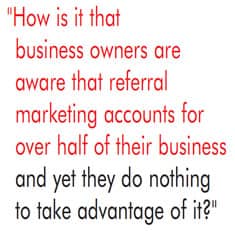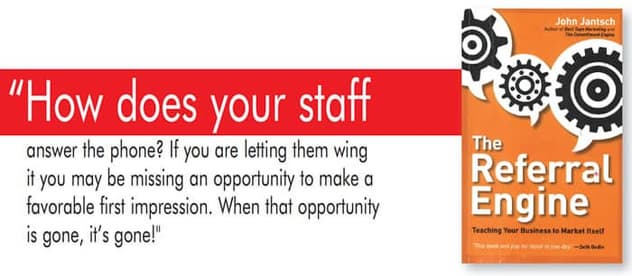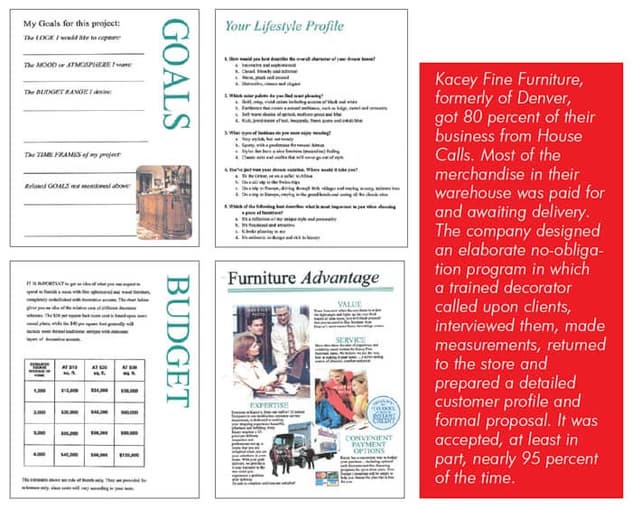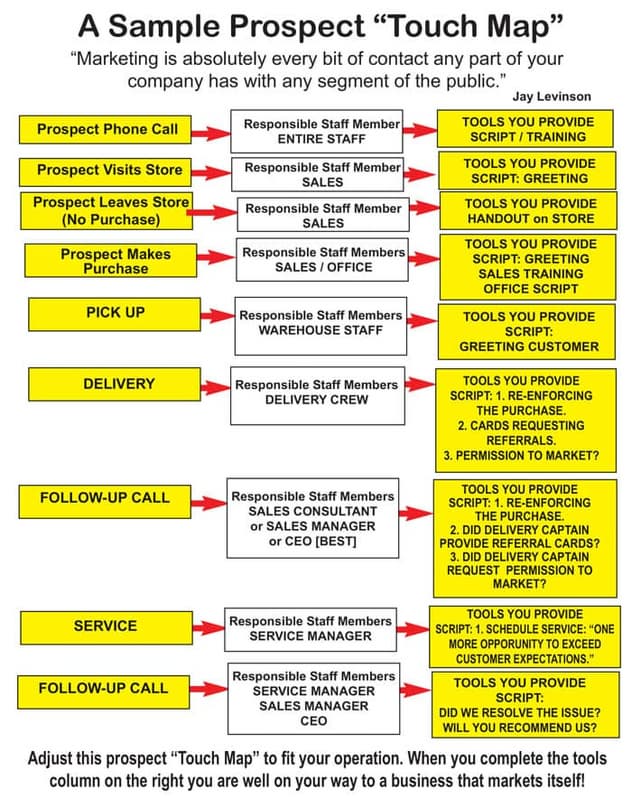Teach your retail home furnishings business to market itself, to harness the magic of word-of-mouth marketing.
The other day I was at Home Depot when a special display caught my eye.
It was for a fancy titanium gardening tool. It was about time to trim my one crepe myrtle tree. But I just couldn’t make up my mind whether to buy the new tool on impulse or just forget it. I read all the hype printed on the packaging (“Super Blade Technology; 32 inch Power Gear By-Pass Zapper; Two-Inch Capacity.”) But I just couldn’t decide. Suddenly some guy came by and said: “Get it. It is the best tool I ever bought. You’ll love it.” Then this stranger was gone.
Yes, I bought the titanium wonder and had no regrets. But, how is it that a total stranger influenced my purchase? That is the magic of referral and word of mouth marketing, the subject of this article.
A Tragic Referral Reality
According to a marketing survey of several thousand small businesses by author John Jantsch, 63.4 percent of the owners felt that over half of their business came from referrals. But of that same group, 79.9 percent admitted they had no system of any kind to generate referrals.
I found this puzzling. How is it that business owners are aware that referral marketing accounts for over half of their business and yet they do nothing to take advantage of it? Consider this explanation from one of the business people John Jantsch interviewed for his book, "The Referral Engine."
“We have trouble getting and asking for referrals from our customers. We ask and they say, ‘I’ll keep it in mind.’ When we offer an incentive we still get nothing. Because of that, we just don’t ask! I would think getting referrals from happy customers would be easier!”

Jantsch drilled down deeper in his survey. He heard many excuses for failing to get testimonials and referrals such as fear, they didn't think to ask, etc. But, the bedrock truth he discovered was:
“You know how powerful a referral can be, but you’re not doing anything worth being talked about. Or, if you are, you lack an authentic and systematic approach to stimulating conversations, collecting leads, educating prospects, and converting those referrals into customers.”
Certainly, most furniture store independents could report a similar experience. But, so what? How important are referrals in the business cycle? The late Jay Levinson (author of "Guerrilla Marketing") put it this way:
“Marketing is absolutely every bit of contact any part of your company has with any segment of the public. Guerrillas view marketing as a circle that begins with your ideas for generating revenue and continues with the goal of amassing a large number of repeat and referral customers."

This article will show you how to start teaching your associates how to create a business that markets itself. Not by linearly adding customers, but rather by enlarging the size of each ticket, generating more repeat sales, and embracing the massive referral power of your happy customers to add new ones.
The "Touch Cycle"
Disney created his brand largely by providing his staff with scripts. For example, the very first opportunity you have to impress a prospect that yours is a different kind of store, may be the first time they call you. How does your staff answer the phone? Do they have a script or do you let them wing it? Here is an example of an excellent one: “Hello! It’s a great day at Leather by Design! My name is Jane… how may I help you?”
If you are letting them wing it, you may be missing an opportunity to make a favorable first impression. When that opportunity is gone, it’s gone! Check the Customer Touch Point exhibit in this article. The base of the triangle includes a list of business areas where scripts may help to achieve your goal of creating an automatic referral system.
What Makes You a Different Kind of Furniture Store?
I asked this question to a client and he quickly replied: “We are a different kind of furniture store because we are a hometown, family owned and operated business, and we obsess about customer service.” That is his story. It has the potential of being buzz-worthy. This client does have a buzz-worthy Facebook presence and 44 five-star reviews. Content is king, and when a retailer is able to provide information to prospects that will improve their lives, he or she will become a trusted source of information.
Every year, home furnishings retailers who attend major and regional wholesale markets return home with a great deal of new information about new designs, trends, furniture designers, finishes, features and benefits. Some may share a watered down version of this information with their sales and advertising staff, but the idea of sharing this potentially valuable content with customers usually does not occur to these retailers.

Consider a blog and/or a newsletter to inform your customers about what is new in the vast and varied world of home furnishings. Adapt information published by market centers and their style spotters. Attend design seminars at shows, subscribe to design magazines. You may have to hire a skilled copywriter to take your cliff notes and convert them into compelling copy. But if you want to achieve the goal of a company that markets itself, you must touch all four hot spots of marketing, which are, according to John Jantsch, Content, Context, Connection and Community.
The first is the relevant CONTENT you collect. A good writer must convert your cliff notes into the proper CONTEXT, so it will be relevant to the prospect. Then comes the paradox of CONNECTION. As Jantsch puts it: “The more connected we become through technology, the more we long for real connection involving live interactions.”
Which leads us to the last of the Cs: COMMUNITY. “While the process of building community online has become a very commonplace practice, the opportunity for community building offline is richer than ever.” A balance between online and offline is necessary. There is danger in relying solely on one or the other. Your authentic referral system serves you best when you are clear about your company’s value. You are building a culture of automatic referral, and you can expect referrals that are both authentic and profitable.
Jay Abraham Said It Best
“If you fail to value, acknowledge, and respect the worth of what you have done, what you do, and how much more you should be doing for your clients… if you don’t respect and revere that, it’s shameful. If you DO respect and revere that, you have a causal purpose to do even more. And also help your clients appreciate it so they can understand the significance of what it means to their lives.”
So, what more could you actually do for your clients? One idea is to consider offering House Calls. Sam Fishbein, formerly of Kacey Fine Furniture in Denver, generated 80 percent of his business from House Calls, the result of a no-obligation program we developed, in which a trained decorator called upon clients, interviewed them, made measurements, returned to the store and prepared a formal proposal. It was accepted, at least in part, nearly 100 percent of the time.
Your Business Model
Your sales team has been trained to reinforce your image as a different kind of home furnishings store. They have been given the tools to embellish this image by sprinkling comments throughout their conversation like: “Most furniture sales people attempt to close a sale. We are different. We try to open a relationship.” “Our purpose is to strive to make your life better.” “We provide educational informational content in our messages because the more you know about leather and leather care, the better it will be for you.”

Jay Levinson once wrote that modern technology provides a blatantly unfair advantage to smaller independent stores. High tech has become easy tech. Being connected has never been so low in cost and yet so high in value. It has given the smaller independent access to the speed of email, the power of fresh information, the warmth of closely connected people and the miracle of the Internet. And once you are established online, you have a multitude of choices to create a buzz offline.
Meeting Authentic Needs
Offline, on the sales floor, genuine empathy helps you drill down to the authentic needs of prospects. The old feature-benefit formula has given way to a compelling content-driven feature-benefit-dream process. Let me explain. Traditionally, product features were used to support benefits. For example: “This mattress has 800 pocketed coils that will cradle you in comfort all night,” adequately explains the feature-benefit story. But if you drill down to the customer’s ultimate needs you could add: “… so you can greet the dawn pain-free, refreshed, and ready for anything.” Thus the accumulation of benefits supports the deeper health rewards of a new premium mattress.
A Permission Marketing Strategy
We cannot escape intrusive advertising messages. They are everywhere. It’s a fragmented, crowded marketplace. Seth Godin, the master of permission marketing, wrote: “In a busy marketplace, not standing out is the same as being invisible.” Our purpose in examining the prospect’s “Touch Points” is to stand out and not be invisible. Please note that part of the process is to ask for permission to send marketing messages and information to the client. Once you have been granted this permission, everything changes. Now you are not marketing to strangers you are marketing to friends. You can move your marketing out of the area of reach and frequency into the precious realm of trust. So, what is the difference between being in the category of being intrusive and being in the realm of trust?
There are three important differences.
1. Your message will be anticipated. Clients will actually look forward to hearing from you.
2. Your message will be personal. It will directly relate to the client.
3. Your message will be relevant. You know for sure your message will address something the client is interested in.
A “Touch Map” of what you need to do in terms of training and script creation to get positive comments and referrals can be created from your list of touch points. This forms a solid basis for your new referral strategy. It opens your mind to pursue higher and better pathways and practices. Your only task is to supply the tools such as scripts and specific tactical directives for your team to follow. When doing this, be sure to keep in mind your store’s achievements, value, and how these attributes are connected to the benefits you provide for your clients. Make your appeals personal and with due humility.
Most stores are dominated by tactical thinking, not strategic wisdom. During the past recession, tactical gimmicks damaged the credibility of many independents and franchises who ran “flavor of the week” tactical promotions. However, the stock market and consumer confidence are now at all-time highs. In my judgment the retail furniture industry is trembling on the very brink of prodigious exponential growth. Now is the time for independents to create a massively effective referral program.

In Part One of this referral presentation we have relied primarily on the philosophies and ideas of John Jantsch and his book “The Referral Engine”. This subject is so important that in the second installment (May/June Furniture World) we will consider the perspective of bestselling author Andy Sernovitz and his book, "Word of Mouth Marketing... How Smart Companies Get People Talking." The chances are these revolutionary thinkers will open your eyes to a completely new way of doing business, and change how you approach our advertising-saturated world.
Larry Mullins is a contributing editor for Furniture World and has 30+ years of experience on the front lines of furniture marketing. Larry’s mainstream executive experience, his creative work with promotion specialists, and mastery of advertising principles have established him as one of the foremost experts in furniture marketing. His affordable High-Impact programs produce legendary results for everything from cash raising events to profitable exit strategies. His newest books, THE METAVALUES BREAKTHROUGH and IMMATURE PEOPLE WITH POWER… How to Handle Them have recently been released by Morgan James Publishing. Joe Girard, “The World’s Greatest Salesman” said of this book: “If I had read Larry Mullins’ book when I started out, I would have reached the top much sooner than I did.” Larry is founder and CEO of UltraSales, Inc. and can be reached directly at 904.794.9212 or at Larrym@furninfo.com. See more articles by Larry at www.furninfo.com or www.ultrasales.com.